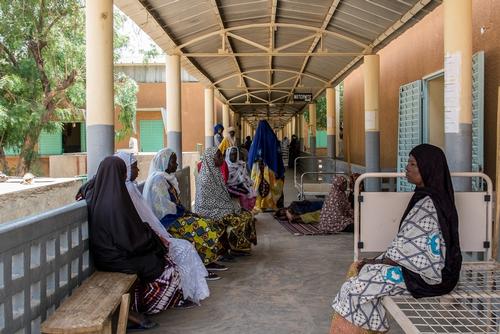Seïdina Ousseini has been MSF field coordinator in Ansongo, in the north of Mali, for one year. He explains us the difficulties facing the MSF teams to provide medical aid to the population affected by the political crisis and insecurity in the African country.
Since when has MSF been working in the north of Mali?
MSF has been working in this area of the country since September 2012, after the crisis erupted following the occupation of the northern region by various armed groups. At that time, we were giving support to four community health centres, as well as the reference health centre in the town of Ansongo, in the Gao region. Since January 2014, we now only work at the centre in Ansongo. MSF is the only independent health organisation in the area offering free quality medical assistance to the population. Until now, the lack of human and financial resources has made it difficult for the Malian authorities to assist the population in the north of the country.
What difficulties did you find in such a diverse and complex setting?
It isn’t easy to work in this context, mainly because of the political crisis in the area. The activity of the armed groups makes security very volatile. The difficulties have been increasing and a large part of the Malian population has very limited access to medical care. Today, humanitarian aid is more necessary than ever in northern Mali. For example, in May 2104, after the towns of Kidal and Menaca were captured by pro-Azawad armed groups, we saw how the population experienced moments of real panic which caused a lot of administration staff to flee to the town of Gao and even some hospital patients abandoned their beds in the hospital and fled to the town to seek refuge.
What are the main needs of the population?
In the current context in northern Mali there are multiple needs, including health, education and access to clean water. Health centres either do not work well or are not adequately equipped, with a great lack of staff and basic medicine. Schools are lacking both adequate infrastructures to receive students and teachers who can teach. Access to drinking water is precarious because the wells have deteriorated through lack of maintenance, which has led people use water without proper hygienic conditions.
What were activities carried out by MSF in 2014 in the zone?
At the Ansongo reference centre, the teams work together with the Malian Ministry of Health staff. The main activities there focus on outpatient care, maternity, paediatrics, patients admitted to the hospital, the laboratory and pharmacy, as well as referring the most serious cases to the Gao regional hospital where there is greater capacity. In 2014, we carried out more than 47,000 consultations, more than a quarter of which were children under the age of five. In the same year, about 1,600 patients were hospitalised and our teams assisted more than 800 births and more than 100 caesareans.
Moreover, we initiated a chemoprevention campaign against malaria, as well as a triage on the state of malnutrition among the child population in collaboration with other organisations. Around 40,000 children, aged between three and five years, received preventive antimalarial treatment, enabling them to be protected during the four months of highest incidence of the epidemic, from July to October. We were able to provide medical care to a very geographically dispersed population despite the complicated insecurity context existing in the region.
How were the MSF teams working with the Ministry of Health?
The reference health centre we are supporting is managed by a Director General of Health from the Ministry of Health. Since the crisis broke out many health ministry workers have fled, forcing local youth to replace nurses and doctors who headed south.
How do you rate the Ansongo project?
Despite all the difficulties we have to face, we must keep working to provide assistance to the population in need. It’s a nice project with big challenges, both professionally and personally. The particularity of this area forces us to be patient, to take into account the differences in order to avoid any misunderstanding as much as possible.
Ansongo context
Mali is in the Sahel region of Africa. Two-thirds of the country is desert with temperatures of up to 45 degrees Celsius in the shade from April to June, and insufficient rainfall in the few rainy months from July to October, above all in the northern region. Ansongo, in the north of the country, is one of the four administrative divisions subdivided in 19 health areas. Ansongo is in the Gao region, the heart of the Azawad area, claimed by the National Movement for the Liberation of Azawad and unilaterally declared independent in 2013. It is mainly inhabited by Songhais and Fulanis, pastoral groups that mostly live off agriculture and livestock, and who live together with Tuaregs and Arabs, especially Nomads, distributed in different health areas at distances of up to 50kms from Ansongo. Islam is the main religion of the country.
MSF has been working in the Gao region since November 2012 providing medical care to the populations affected by the armed conflict. In 2014, MSF concentrated its activities at the Ansongo reference health centre, the reference centre for a district with a population of more than 162,000 people.



